Volvo 960 1996 Owner Manual

1996 Volvo 960
960 Owner's Manual
VOLVO 960 1996
 This manual deals with the operation and care of your Volvo.
This manual deals with the operation and care of your Volvo.
Welcome to the world-wide family of Volvo owners. We trust that you will enjoy many years of safe driving in your Volvo, an automobile designed with your safety and comfort in mind. To help ensure your satisfaction with this vehicle, we encourage you to familiarize yourself with the equipment descriptions, operating instructions and maintenance requirements/recommendations in this manual. We also urge you and your passengers to wear seat belts at all times in this (or any other) automobile. And, of course, please do not operate a vehicle if you may be affected by alcohol, medication or any impairment that could hinder your ability to drive.
Your Volvo is designed to meet all applicable safety and emission standards, as evidenced by the certification labels attached to the driver's door opening and on the left wheel housing in the engine compartment.
 Contents
Contents
file:///K|/ownersdocs/1996/1996_960/96960_000.htm (1 of 2)12/30/2006 10:12:26 AM

1996 Volvo 960
Instruments and controls ... 1
Body and interior ... 2
Occupant safety, Reporting safety defects ... 3
Starting and driving ... 4
Wheels and tires ... 5
In case of emergency ... 6
Car care ... 7
Service and routine maintenance ... 8
Specifications ... 9
Important
Before you operate your car for the first time, please familiarize yourself with the BREAK-IN information on page 4:2. You should also be familiar with the information in the first three chapters of this book.
Information contained in the balance of the manual is extremely useful and should be studied after operating the vehicle for the first time. This manual is structured so that it can be used for reference. It should thus be kept in the car for ready access.
Do not export your Volvo to another country before investigating the country's applicable safety and exhaust emission requirements. In some cases it may be difficult or impossible to comply with these requirements. Modifications to the emission control system(s) may render your Volvo not certifiable for legal operation in the U.S., Canada or other countries.
All information, illustrations and specifications contained in this manual are based on the latest product information available at the time of publication. Volvo reserves the right to make model changes at any time, or to change specifications or design, without notice and without incurring obligation.
©1995 Volvo Cars of North America, Inc.
Contents | Top of Page
file:///K|/ownersdocs/1996/1996_960/96960_000.htm (2 of 2)12/30/2006 10:12:26 AM
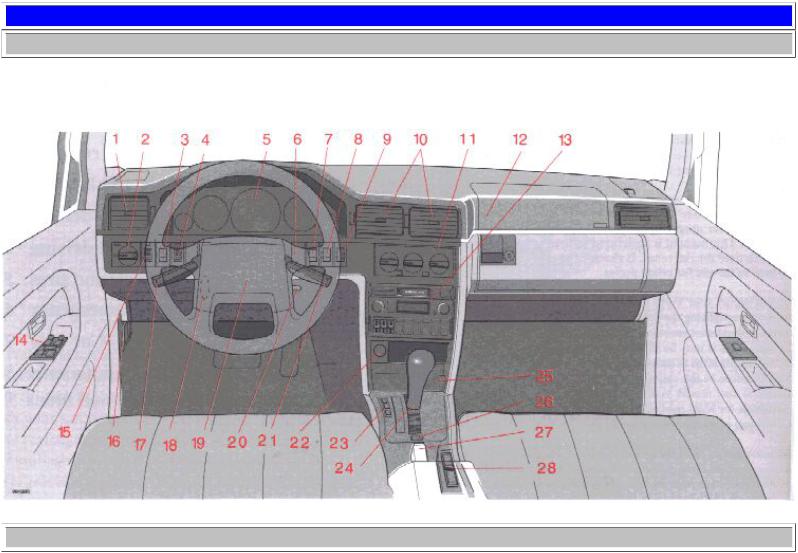
1996 Volvo 960
 Instruments, switches and controls
Instruments, switches and controls
 Instruments, switches and controls
Instruments, switches and controls
 pg. 1:1 Instruments, switches and controls
pg. 1:1 Instruments, switches and controls
IMPORTANT!
Your car is equipped with a Shiftlock-Keylock system.
SHIFTLOCK:
When your car is parked, the gear selector is locked in the (P)ark position. To release the selector from this position, turn the ignition key to position II (or start the engine), depress the brake pedal, press the button on the front side of the gear selector and move the selector from (P)ark.
If it is necessary to manually override the Shiftlock system, see page 4:9 for instructions.
KEYLOCK:
This means that when you switch off the ignition, the gear selector must be in the (P)ark position before the starting (ignition) key can be removed from the ignition switch.
ANTI-LOCK BRAKE SYSTEM (ABS):
The ABS system in your car performs a self-diagnostic test when the vehicle is started and at 4 mph (6km/h). The driver may detect one pulsation of the brake pedal and a sound will be audible from the ABS control module. This is normal.
The pages in this section provide detailed descriptions of the vehicle's instruments and controls.
Note that vehicles may be equipped differently, depending on special legal requirements.
file:///K|/ownersdocs/1996/1996_960/96960_101.htm (1 of 6)12/30/2006 10:12:28 AM

1996 Volvo 960
Some of the items below are available on certain models only.
1:11 |
Air vent |
1:6 Headlights, parking lights
1:8 Front/rear fog lamps
1:8 Central lock switch
1:1-1:5 Instruments
- |
Space for additional equipment |
1:9, 2:19 Electrically operated sun roof
1:9 Hazard warning flashers
1:9 Heated rear window/side door mirrors
1:11 |
Air vents |
1:11-1:15 Heating and ventilation
3:4, 3:6 SRS (air bag), passenger's side
1:19-1:62 Audio system
1:17 Controls for electrically operated windows
2:5 and side-view mirrors
1:8 Instrument panel illumination
2:9 Hood-release handle
1:6 Turn signals, high/low beams,
1:10 cruise control
1:8 Adjustable steering wheel
3:4 SRS (air bag)/Horn
1:7 Starting (ignition) switch/steering wheel lock
1:7 Windshield wiper/washer
1:7 headlight wiper/washer (certain models)
1:9 rear window wiper/washer (wagons)
1:18 Cigarette lighter
4:7 Transmission mode selector buttons
4:6 Gear selector
1:18 Ash tray
4:9 Shiftlock override button
1:18 Parking brake
1:16 Electrically-heated front seats (certain models)
 pg. 1:2 Instruments
pg. 1:2 Instruments
1 Ambient temperature indicator (certain models)
Indicates the temperature slightly above the surface of the road. An amber warning lamp lights up when the temperature is in the range of 23-36° F (-5 - + 2° C). At low speeds or when the car is not moving, the temperature readings may be slightly higher than the actual ambient temperature due to heat generated by the engine.
2 Fuel gauge
file:///K|/ownersdocs/1996/1996_960/96960_101.htm (2 of 6)12/30/2006 10:12:28 AM

1996 Volvo 960
The total fuel tank capacity is approx. 21.1 US gals (80 liters). The "usable" capacity is 20.3 US gallons (77 liters). When the warning light comes on, there are approximately 1.6 US gals. (6 liters) of fuel remaining in the tank. See "Refueling" for further information.
3 Quartz crystal clock/clock set button
Press the button and turn to set the clock.
4Speedometer
5Odometer
6Trip odometer/reset button
Used for measuring shorter distances. The last digit indicates 1/10 mile/kilometer. A black number on a white background = original speedometer. A red number on a white background = replacement speedometer.
7 Tachometer
Reads thousands of engine rpm. Engine should not be operated in red range.
8 Temperature gauge
The pointer should be approximately midway on the gauge face when driving. If the pointer approaches the red range repeatedly, check coolant level. Do not drive the car with the pointer in the red range. See "Coolant" section.
Warning! Allow engine to cool before adding coolant.
 pg. 1:3 Indicator and warning lights
pg. 1:3 Indicator and warning lights
file:///K|/ownersdocs/1996/1996_960/96960_101.htm (3 of 6)12/30/2006 10:12:28 AM
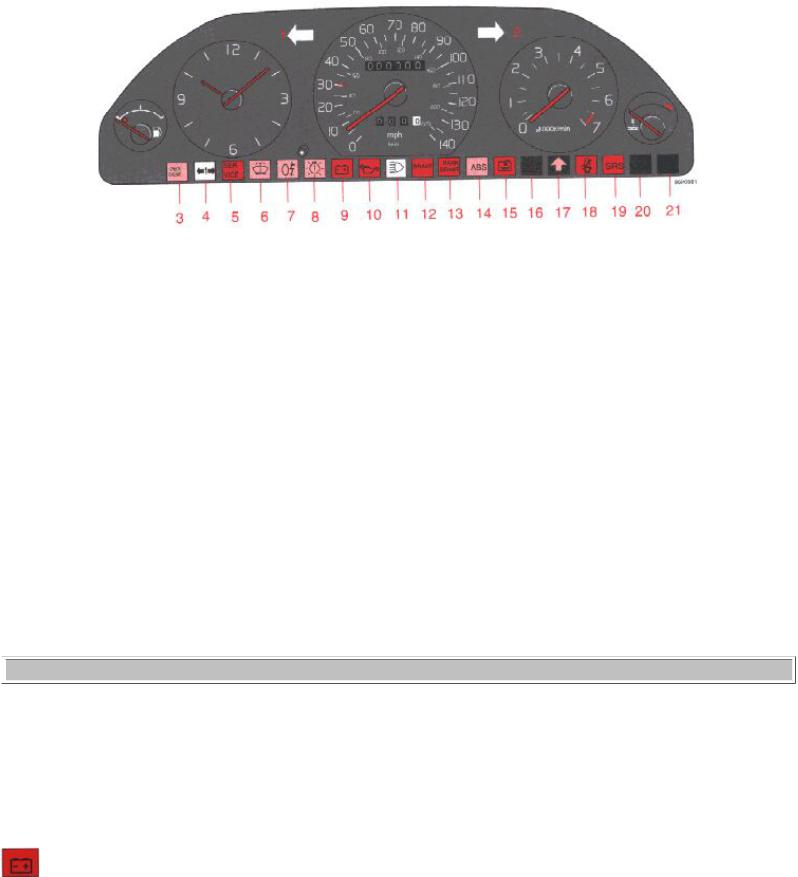
1996 Volvo 960
1 Turn signal, left
2 Turn signal , right
3 Malfunction indicator lamp
4 Direction indicator, trailer
5 Service reminder indicator
6 Low washer fluid level
7 Rear fog lamp
8 Bulb failure
9 Generator not charging
10 Low engine oil pressure
11 High beams
12 Brake failure
13 Parking brake applied
14ABS-system
15Low coolant level
16(Not in use)
17"Winter" mode engaged/transmission fault
18Fasten seat belts
19SRS
20(Not in use)
21(Not in use)
 pg. 1:4 Warning lights
pg. 1:4 Warning lights
The warning lights described on pages 1:4 and 1:5 should never stay on when driving
When the ignition key is turned on, and before the engine starts, all of the warning lights should be on to test the function of the bulbs. Should a light not go off after the engine has started, the system indicated should be inspected. However, the parking brake reminder light will not go off until the parking brake is fully released.
Generator warning light
If the light comes on while the engine is running, check the tension of the generator drive belt as soon as possible.
file:///K|/ownersdocs/1996/1996_960/96960_101.htm (4 of 6)12/30/2006 10:12:28 AM
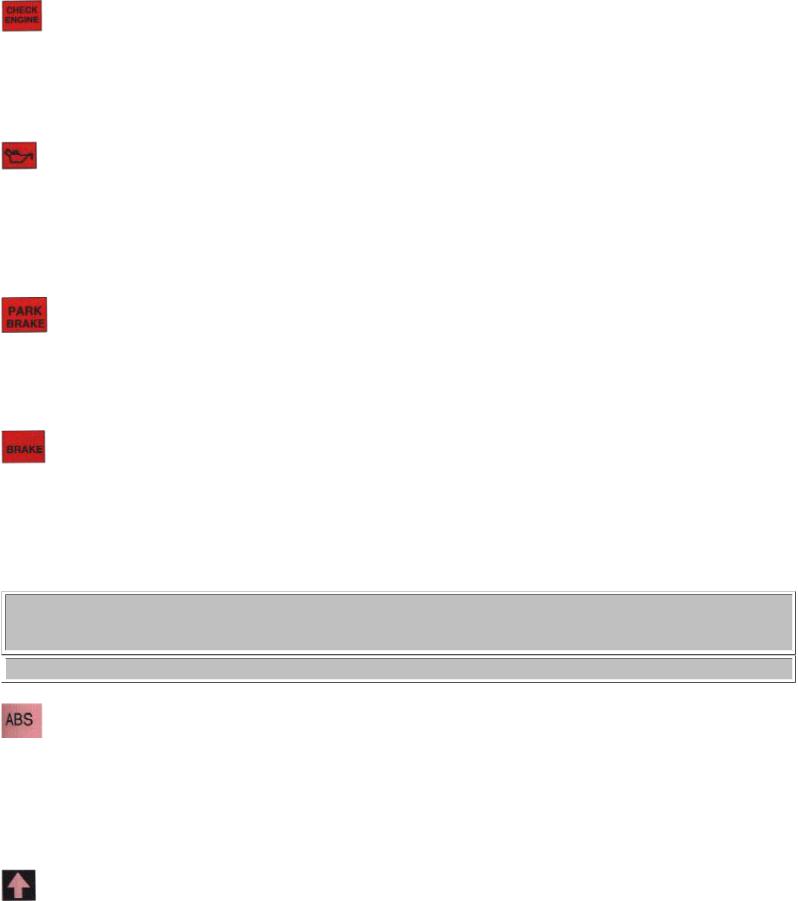
1996 Volvo 960
Malfunction indicator lamp
If the lamp comes on (or stays on after the vehicle has started), the engine diagnostic system has detected a possible fault in the emission control system. Although driveability may not be affected, see an authorized Volvo retailer as soon as possible for inspection.
Oil pressure warning light
If the light comes on while driving, the oil pressure is too low. Stop the car and then stop the engine immediately and check the engine oil level. See the section titled "Engine oil". If the light stays on after restart, have the car towed to the nearest authorized Volvo retailer. After hard driving, the light may come on occasionally when the engine is idling. This is normal, provided it goes off when the engine speed is increased.
Parking brake reminder light
This light will be on when the parking brake (hand brake) is applied. The parking brake lever is situated between the front seats. Canadian models are equipped with this warning light: 
Brake fluid warning light
If the light comes on while driving or braking, this indicates that the brake fluid level is too low.
Stop immediately, open the hood and check the brake fluid level in the reservoir (see section "Engine compartment" for reservoir position)!
Canadian models are equipped with this warning light:
WARNING!
If the level is below the MIN mark in either section of the reservoir: DO NOT DRIVE. Tow the car to a Volvo retailer and have the brake system checked and any leakage repaired.
 pg. 1:5 Warning lights
pg. 1:5 Warning lights
Anti-lock Brake System (ABS)
If the warning lamp lights up there is a malfunction of the ABS system (the standard braking system will however function). The vehicle should be driven to a Volvo retailer for inspection.
See page 4:15 for additional information.
Canadian models are equipped with this warning light: 
Mode "W" engaged
The lamp will light up when the Winter/Wet mode is engaged.
If the warning lamp begins to flash , this means that there is a fault in the automatic gearbox.
Contact your Volvo retailer.
file:///K|/ownersdocs/1996/1996_960/96960_101.htm (5 of 6)12/30/2006 10:12:28 AM

1996 Volvo 960
Supplemental Restraint System (SRS)
If the light comes on (or stays on after the vehicle has started), the SRS diagnostic system has detected a fault. Drive to an authorized Volvo retailer for an inspection of the system. See the SRS section for more information.
Service reminder indicator
This light will come on at 10,000 mile (16,000 km) intervals. It is a reminder to the driver that the 10,000 mile (16,000 km) service interval has been exceeded. The light will stay on 2 minutes after the start until reset by the servicing retailer.
Coolant level sensor
If the light comes on while driving, the coolant level is low. The coolant level in the expansion tank should be checked immediately and topped off if necessary. The cooling system should be inspected by an authorized Volvo retailer.
Turn signal indicators-trailer (certain models)
When towing a trailer, this light will flash simultaneously with the turn signals on the trailer. If the light does not flash when signaling, neither the trailer's turn signals nor the car's turn signals are functioning.
Bulb failure warning light
The light will come on if any of the following bulbs are defective: one of the low beam headlights
one of the tail lights
one of the brake lights when the brake pedal is depressed. Check the fuse and bulb.
See sections titled "Replacing bulbs" and "Fuses".
Contents | Top of Page
file:///K|/ownersdocs/1996/1996_960/96960_101.htm (6 of 6)12/30/2006 10:12:28 AM

1996 Volvo 960
 pg. 1:6 Lighting, Turn signals
pg. 1:6 Lighting, Turn signals
Headlights and parking lights
 All lights off *
All lights off *
 Parking lights on **
Parking lights on **
 Headlights and parking lights are on if starting (ignition) switch is in position I or II.
Headlights and parking lights are on if starting (ignition) switch is in position I or II.
If the headlight switch is in position  all lights will go out when starting switch is switched off. With the headlight switch in position
all lights will go out when starting switch is switched off. With the headlight switch in position  the parking lights will stay on (headlights off) with the daytime running light switch (A) in position
the parking lights will stay on (headlights off) with the daytime running light switch (A) in position  .
.
The high beams can only be switched on if the headlight switch is in position  .
.
Switch from high to low beams, and vice versa, by moving the turn signal switch lever on the left side of the steering column towards the steering wheel.
* Models equipped with daytime running lights: The low beams, tail lights, parking lights and license plate lights will come on automatically when the ignition is switched on.
Automatic daytime running lights
NOTE: The daytime running light function may only be disabled (turned off) in the U.S. - Canadian law mandates the use of daytime running lights.
Screw A in the illustration (available on U.S. models only) is used to control the automatic daytime running lights when the headlight switch is in position 0. To adjust, press in the screw with a small screwdriver and turn to one of the following positions:
 Automatic daytime running lights
Automatic daytime running lights
 Automatic daytime running lights
Automatic daytime running lights
** The daytime running lights will also function when the headlight switch is in position  and switch A is in this position.
and switch A is in this position.
 All lights off (daytime running light function disabled)
All lights off (daytime running light function disabled)
file:///K|/ownersdocs/1996/1996_960/96960_106.htm (1 of 8)12/30/2006 10:12:30 AM

1996 Volvo 960
Turn signals
1 Lane change position : In maneuvers such as lane changing, the driver can flash the turn signals by moving the turn signal lever to the first stop and holding it there. The lever will return to the neutral position when released.
2 Signal lever engaged for normal turns
3 High beam/low beam switch (headlights on)
Move the lever towards the steering wheel and release it. Headlight flasher (headlights off)
Move the lever towards the steering wheel.
The headlight high beam will be on until the lever is released.
NOTE: Defective turn signal bulbs will cause turn signal indicator and remaining signal lights to flash more rapidly than normal.
 pg. 1:7 Windshield wipers/washers, Ignition switch
pg. 1:7 Windshield wipers/washers, Ignition switch
file:///K|/ownersdocs/1996/1996_960/96960_106.htm (2 of 8)12/30/2006 10:12:30 AM

1996 Volvo 960
Wipers/washers
1 Intermittent wiper.
With switch in this position, the wipers will sweep approximately every seventh second. 2 "Single sweep" position.
Switch returns automatically when released 3 Wipers, low speed.
4 Wipers, high speed
5 Windshield wiper/washer, headlight wiper/washer (certain models)
The wiper will make 2-3 complete sweeps across the windshield and headlights after lever is released.
Starting (ignition) switch/steering wheel lock
The steering wheel lock might be under tension when the car is parked. Turn the steering wheel slightly to free the ignition key. In order to reduce car theft, make sure the steering wheel lock is engaged before leaving the car.
A chime will sound if the starting key is left in the ignition lock and the front door on the driver's side is opened.
file:///K|/ownersdocs/1996/1996_960/96960_106.htm (3 of 8)12/30/2006 10:12:30 AM
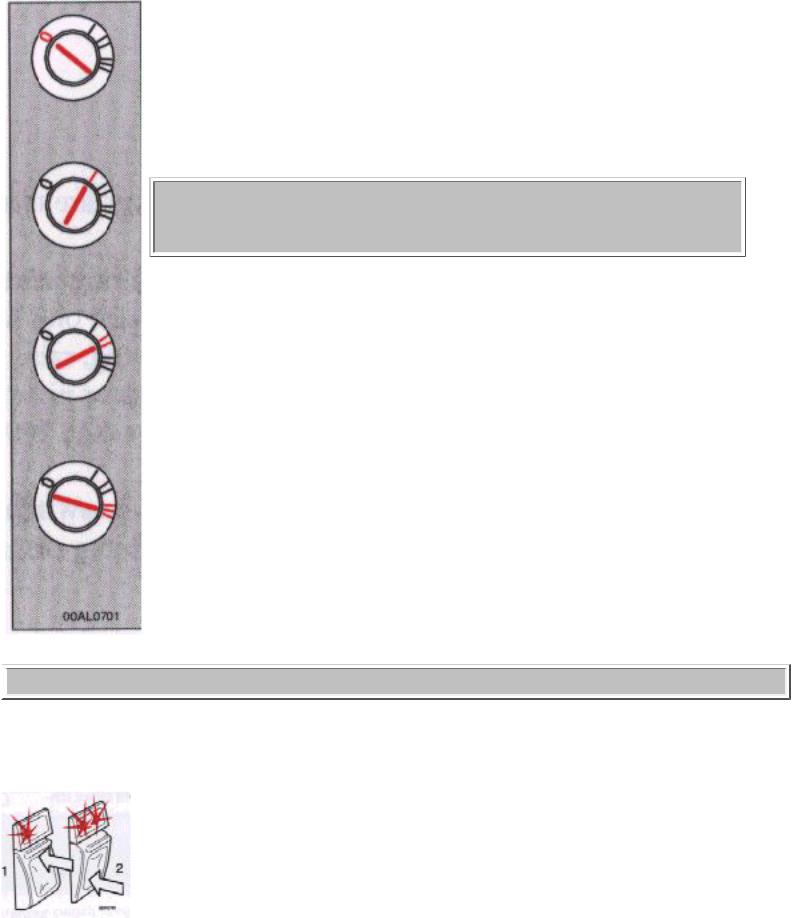
1996 Volvo 960
0 Locked position:
remove the key to lock the steering wheel.
WARNING:
Never turn the key to position 0 while driving or when the car is being towed.
I Intermediate position:
Certain accessories/radio, etc. on, daytime running lights off. II Drive position:
key position when engine is running. III Starting position:
release the key when the engine start. The key returns automatically to the Drive position.
* The gear selector must be in the (P)ark position before the key can be removed from the ignition switch.
 pg. 1:8 Fog lights, Instrument illumination, Steering wheel adjustment
pg. 1:8 Fog lights, Instrument illumination, Steering wheel adjustment
A - Front and rear foglights
The switch has two settings: 1 Front foglights ON.
file:///K|/ownersdocs/1996/1996_960/96960_106.htm (4 of 8)12/30/2006 10:12:30 AM

1996 Volvo 960
2 Front and rear foglights ON.
When both front and rear foglights are turned on both indicators will light.
The rear foglight is considerably brighter than the normal tail light and should be used only when the atmospheric conditions, such as fog, rain, snow, smoke or dust reduce the daytime or nighttime visibility of other vehicles to less than 500 ft (150 meters).
The lowbeam headlights must be switched on. Note that local regulations governing the use of these lights may vary.
B - Instrument illumination
To increase the brightness, rotate the switch upward.
To decrease the brightness, rotate the switch downward.
C - Central lock switch
Press the switch to lock/unlock the doors and trunk/tailgate.
Lock: press the lower section of the switch
Unlock: press the upper section of the switch.
D - Steering wheel adjustment
The steering wheel can be adjusted to 3 different positions.
Move the control on the left side of the steering column downward and hold it in place. Adjust the steering wheel to the position desired. Release the control and check that the steering wheel is locked in position.
WARNING! Do not adjust the steering wheel while driving.
file:///K|/ownersdocs/1996/1996_960/96960_106.htm (5 of 8)12/30/2006 10:12:30 AM
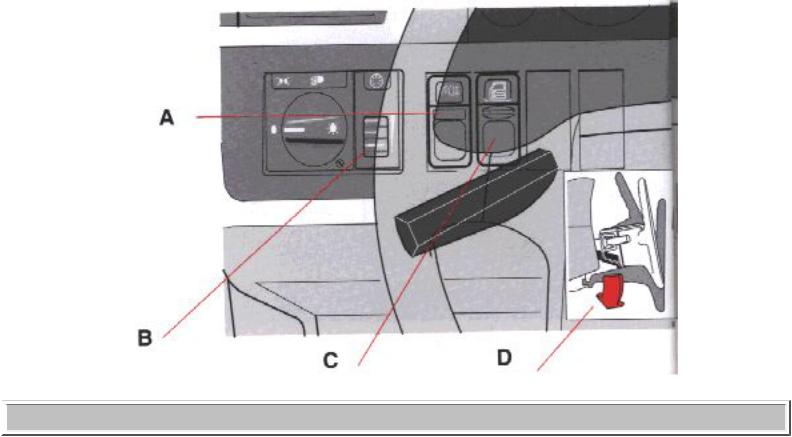
1996 Volvo 960
 pg. 1:9 Sun roof, Hazard warning flasher, Tailgate wiper/washer, heated rear window
pg. 1:9 Sun roof, Hazard warning flasher, Tailgate wiper/washer, heated rear window
Tailgate window wiper/washer (wagon)
The tailgate window wiper/washer is operated by a switch at the end of the wiper level.
1.The wiper operates continuously.
2.Intermittent position: the wiper strokes approximately every 10 seconds.
3.Tailgate washer (note that the wiper also operates when this button is depressed): after the button is released the wiper strokes 2-3 additional times before stopping.
The electrical circuit is protected by fuse 19, located in the central electrical unit. See the section entitled "Fuses".
Electrically operated sun roof (certain models)
The sun roof can be operated in two ways; as a conventional sliding roof; or the rear edge can be raised to provide increased ventilation. On models equipped with the power glass sun roof, a manually operated sun shade is also provided.
See page 2:19 for operating instructions.
NOTE: In case of sun roof malfunction, see page 2:19.
file:///K|/ownersdocs/1996/1996_960/96960_106.htm (6 of 8)12/30/2006 10:12:30 AM
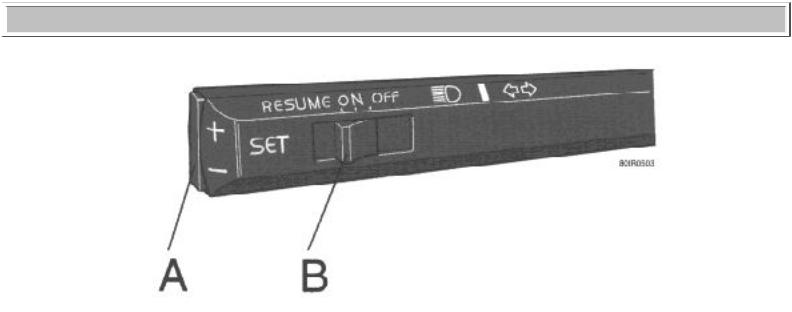
1996 Volvo 960
Heated rear window, heated side-door mirrors (certain models)
Depress the switch to start heating of rear window and side mirrors. Both orange control lights in the switch will illuminate. A timer switches off the side mirror heating after approx. 6 minutes and the rear window demister after 12 minutes. The control lights go out correspondingly.
Hazard warning flasher
The four-way flasher should be used to indicate that the vehicle has become a traffic hazard. NOTE: Regulations regarding the use if the hazard warning flasher may vary from state to state.
 pg. 1:10 Cruise control
pg. 1:10 Cruise control
Cruise control
The cruise control switches are located on the turn signal switch lever.
To engage and set desired speed:
1.Set switch (B) to ON.
2.Accelerate to desired cruise speed.
NOTE: The cruise control cannot be engaged at speeds below 22 mph (35 km). 3. Press the + or - area of the SET button (A) to set the desired speed.
Braking
This will automatically disengage the cruise control. Previously selected cruise control speed is retained
file:///K|/ownersdocs/1996/1996_960/96960_106.htm (7 of 8)12/30/2006 10:12:30 AM

1996 Volvo 960
in the memory and by momentarily setting the switch to RESUME position, that speed will be reengaged.
If the cruise control is already engaged, the cruising speed can be increased or decreased by depressing the SET button (A) towards either + or -. One short press on the button corresponds to a speed change of approx. 1 mph (1.6 km/h). When the button is released, the vehicle will maintain the current speed.
If actual speed falls below 70% of set speed or if the wheels spin or lock, the cruise control will disengage automatically.
NOTE:
When driving in hilly terrain, the gearbox may tend to jump between different gears. This can be avoided by selecting gear selector position 3 (intermediate position).
Normally, the (E)conomy mode should be used when the cruise control is engaged.
Acceleration
Momentary acceleration, such as for passing, does not interrupt cruise control operation. The previously selected speed will be maintained without having to set the switch to RESUME. To disengage the cruise control system : set switch (B) to OFF, depress the brake pedal or move the gear selector to position N.
Switching off the starting (ignition) switch will automatically disengage the cruise control system.
WARNING! The cruise control should not be used in heavy traffic or when driving on wet or slippery roads. Do not use or resume cruise control in reverse gear. When the ignition is switched off, any information stored in the cruise control memory will be erased.
Contents | Top of Page
file:///K|/ownersdocs/1996/1996_960/96960_106.htm (8 of 8)12/30/2006 10:12:30 AM
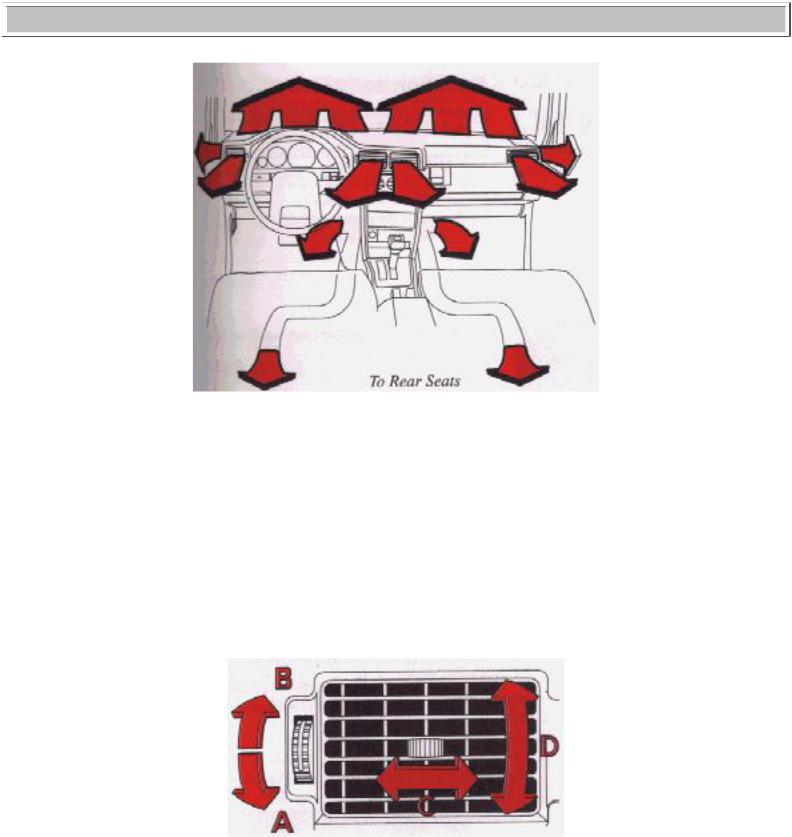
1996 Volvo 960
 pg. 1:11 Heating, ventilation and air conditioning
pg. 1:11 Heating, ventilation and air conditioning
ECC - Electronic Climate Control
This is an automatic system that also permits manual operation. The in-car temperature is automatically monitored by two sensors located in the passenger compartment.
One sensor is located on the top of the dashboard where it can sense sunlight. The second sensor is located on the courtesy light where it can sense the temperature in the center of the car. The following pages describe how ECC works and how it can be used most effectively.
Air vents (dash)
AOpen
BClosed
CDirecting air flow horizontally
file:///K|/ownersdocs/1996/1996_960/96960_111.htm (1 of 8)12/30/2006 10:12:32 AM

1996 Volvo 960
D Directing air flow vertically
 pg. 1:12 Heating, ventilation and air conditioning
pg. 1:12 Heating, ventilation and air conditioning
ECC - Electronic Climate Control panel Blower
0 = off
5 = max speed
aut = blower speed automatically regulated
Function selector Set desired function aut = normal setting
Temperature dial
Set desired temperature
 Air in the passenger compartment recirculates with this button depressed. Will not function in defrost setting. Light is on when recirculation is active*
Air in the passenger compartment recirculates with this button depressed. Will not function in defrost setting. Light is on when recirculation is active*
 The air conditioning system is OFF when this button is depressed (the light will be on). The light has two functions:
The air conditioning system is OFF when this button is depressed (the light will be on). The light has two functions:
file:///K|/ownersdocs/1996/1996_960/96960_111.htm (2 of 8)12/30/2006 10:12:32 AM
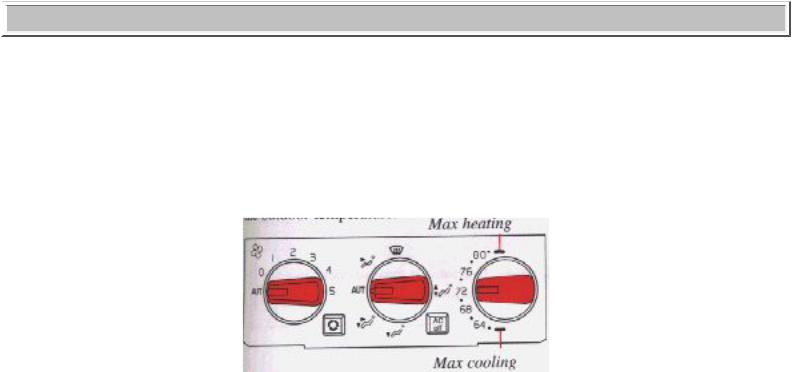
1996 Volvo 960
●air conditioning OFF*
●fault in system (see next page)
*When the function selector is in the  mode, the air conditioning system is ON and recirculation is OFF, regardless of button position. The light surrounding the "AC OFF" button will be OFF and the light surrounding the recirculation button will be OFF.
mode, the air conditioning system is ON and recirculation is OFF, regardless of button position. The light surrounding the "AC OFF" button will be OFF and the light surrounding the recirculation button will be OFF.
NOTE: If your windows begin to fog or mist, check that the recirculation function is not engaged.
Function selector
aut aut=air distribution automatically regulated
 Air through panel vents
Air through panel vents
 Defrost. Air to windshield and side windows.
Defrost. Air to windshield and side windows.
 Air to floor, windshield and side windows.
Air to floor, windshield and side windows.
 Air through floor vents.
Air through floor vents.
 Bi-level. Air through floor and panel vents. Air supplied from panel vents is slightly colder than air released at foot level.
Bi-level. Air through floor and panel vents. Air supplied from panel vents is slightly colder than air released at foot level.
 pg. 1:13 Heating, ventilation and air conditioning
pg. 1:13 Heating, ventilation and air conditioning
Automatic setting
The ECC system will automatically maintain a comfortable in-car temperature regardless of the outdoor temperature.
Select the desired temperature
file:///K|/ownersdocs/1996/1996_960/96960_111.htm (3 of 8)12/30/2006 10:12:32 AM
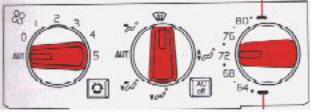
1996 Volvo 960
The blower will run at its maximum speed in either the max cooling or max heating positions. Water under the vehicle in hot weather can be the result of condensation from the air conditioning system.
Optimum defrosting
Set the function dial to  .
.
The air conditioning light will NOT go on.
When the windows have cleared, set the blower control to position 2.
Operating Tips
When the outside air is contaminated with exhaust gases, smoke etc. (as when driving through a tunnel) or to cool the car quickly, push the recirculation button. In this position, no air is drawn into the passenger compartment from outside. However, do not leave the system in this mode for more than 1015 minutes, since the air inside the car will become stale and the windows may fog.
NOTE:
●Do not place any objects over the sensor in the passenger side speaker grille as this will cause the ECC system to respond incorrectly to ambient conditions.
●To help maintain stable passenger compartment temperature when driving with the sun roof or windows open, place the blower control in position "0" and adjust the desired temperature manually.
●The air conditioning compressor only engages at temperatures above 41°F (5°C).
●Always keep the air intake grille at the base of the windshield free of snow.
Volvo cares about the environment. The air conditioning system in your car contains a CFC-free refrigerant - R134a. This substance will not deplete the ozone layer. The system contains 2 lbs. (0.9 kg) R134a and uses Sanden SP-20 (type PAG) oil.
file:///K|/ownersdocs/1996/1996_960/96960_111.htm (4 of 8)12/30/2006 10:12:32 AM

1996 Volvo 960
ECC system fault indication
If the light in the air conditioning push button begins to flash when the ignition is switched on, a simple fault is indicated. The system will compensate by substituting a standard value stored in the memory. System performance loss will be slight.
If the light continues to flash more than 20 seconds, a more serious fault is indicated. While the system will again attempt to substitute a standard value, some reduction in system performance will become apparent. Contact your authorized Volvo retailer for service.
Difficult weather conditions
When driving in very humid conditions, heavy rain, sleet, etc., it may be better to use the manual rather than the automatic setting to defrost the windows. Set the mode selector to "Defrost" or "Defrost/floor" and the fan speed to 3 or higher. Also shut the middle air vents.
 pg. 1:14 Heating and air conditioning (certain models)
pg. 1:14 Heating and air conditioning (certain models)
Heating and ventilation with air conditioning Blower
0 = off
5 = max speed
Function selector
Set desired function
Temperature dial
Set desired temperature
file:///K|/ownersdocs/1996/1996_960/96960_111.htm (5 of 8)12/30/2006 10:12:32 AM
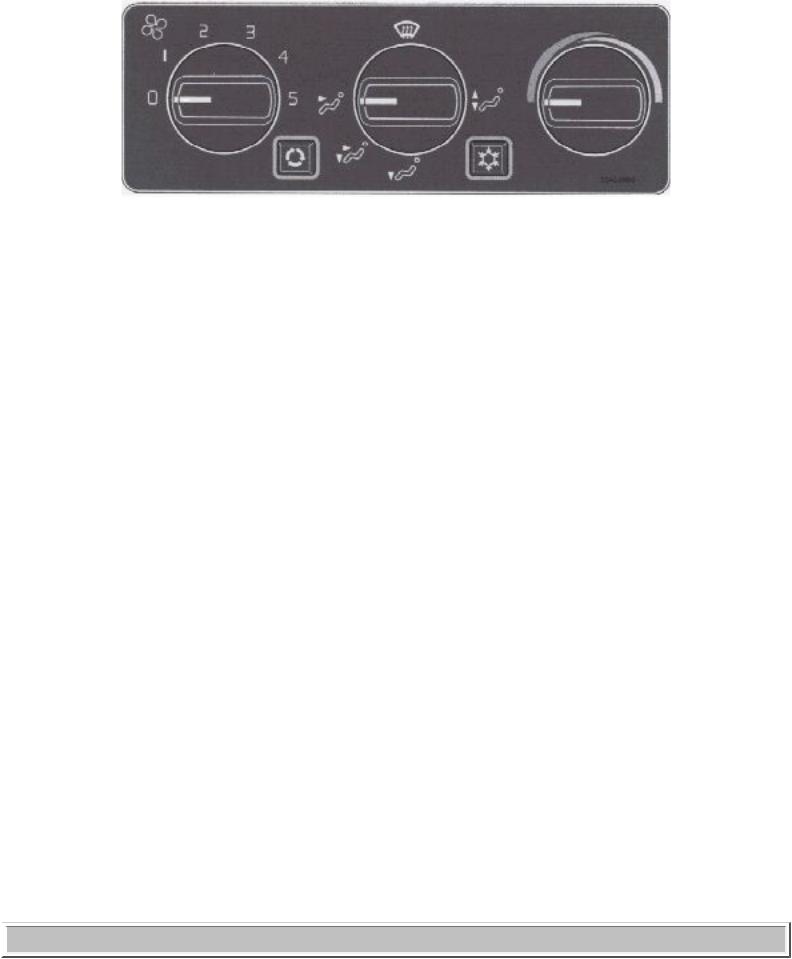
1996 Volvo 960
 Air in the passenger compartment recirculates with this button depressed (will not function in defrost setting). The symbol lights up (orange light) when the button is depressed and the headlights or parking lights are on.
Air in the passenger compartment recirculates with this button depressed (will not function in defrost setting). The symbol lights up (orange light) when the button is depressed and the headlights or parking lights are on.
 The air conditioning system is ON when this button is depressed. The symbol lights up (blue light) when the button is depressed and the headlights or parking lights are on *.
The air conditioning system is ON when this button is depressed. The symbol lights up (blue light) when the button is depressed and the headlights or parking lights are on *.
* When the selector is in the  mode, the air conditioning system is ON regardless of button position.
mode, the air conditioning system is ON regardless of button position.
Function selector
 Air through panel vents
Air through panel vents
 Defrost. Air to windshield and side windows.
Defrost. Air to windshield and side windows.
 Air to floor, windshield and side windows.
Air to floor, windshield and side windows.
 Air through floor vents
Air through floor vents
 Bi-level. Air through floor and panel vents.
Bi-level. Air through floor and panel vents.
NOTE: If your windows begin to fog or mist, check that the recirculation function is not engaged.
 pg. 1:15 Heating and air conditioning (certain models)
pg. 1:15 Heating and air conditioning (certain models)
file:///K|/ownersdocs/1996/1996_960/96960_111.htm (6 of 8)12/30/2006 10:12:32 AM
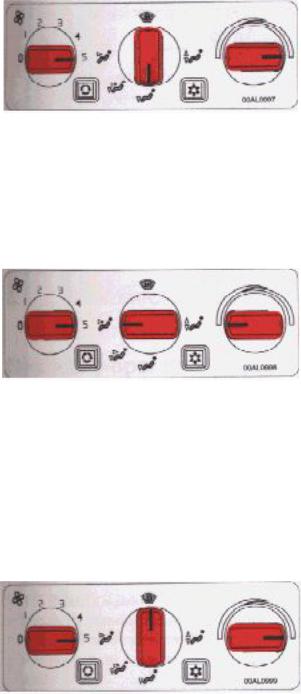
1996 Volvo 960
Maximum heating:
Close the center panel vents. When the passenger compartment has become sufficiently warm, set the blower control to position 2 and adjust the temperature.
Maximum cooling:
Open the vents. The  button should be depressed. Adjust the temperature with the temperature dial.
button should be depressed. Adjust the temperature with the temperature dial.
To demist / Defrost the windows
Set the function dial to position  . When the windows have cleared set the blower control to position
. When the windows have cleared set the blower control to position
2 and the function selector to  . Always keep the air intake grille at the base of the windshield free of snow.
. Always keep the air intake grille at the base of the windshield free of snow.
Operating tips
The air conditioning system functions only at temperatures above 43°F (6°C).
file:///K|/ownersdocs/1996/1996_960/96960_111.htm (7 of 8)12/30/2006 10:12:32 AM

1996 Volvo 960
The air conditioning will only function if the blower is set to position 1 or higher.
 Choose this position if the outside air is contaminated with exhaust gases, smoke, etc or to heat/ cool the car quickly. In this position, very little air is drawn into the passenger compartment from the outside. Do not leave the system in this mode for more than 10-15 minutes since the air inside the car will become stale. The temperature can be controlled with the temperature dial.
Choose this position if the outside air is contaminated with exhaust gases, smoke, etc or to heat/ cool the car quickly. In this position, very little air is drawn into the passenger compartment from the outside. Do not leave the system in this mode for more than 10-15 minutes since the air inside the car will become stale. The temperature can be controlled with the temperature dial.
The air conditioning system will function best if it is used regularly.
Water under the vehicle in hot weather can be the result of condensation from the air conditioning system.
Volvo cares about the environment. The air conditioning system in your car contains a CFC-free refrigerant - R134a. This substance will not deplete the ozone layer. The system contains 2 lbs. (0.9 kg) R134a and uses Sanden SP-20 (type PAG) oil.
Contents | Top of Page
file:///K|/ownersdocs/1996/1996_960/96960_111.htm (8 of 8)12/30/2006 10:12:32 AM
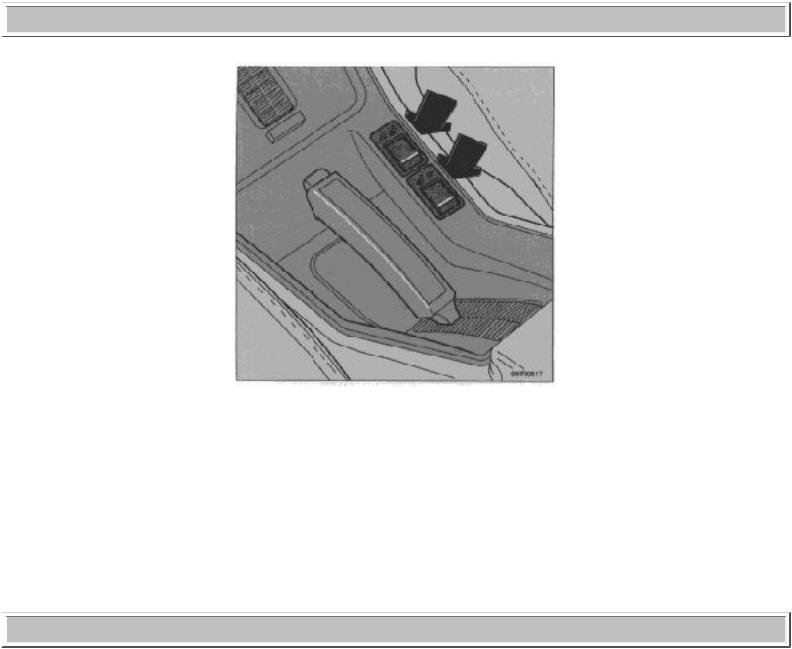
1996 Volvo 960
 pg. 1:16 Heated front seats
pg. 1:16 Heated front seats
Heated front seats (certain models)
The heated front seats can be switched on and off as required. When switched on, the system senses the ambient temperature and regulates the level of heat applied. When the optimum temperature is reached, the heating is switched off automatically.
While driving, the passenger seat heating should be switched off when the seat is not occupied.
 pg. 1:17 Electrically operated windows
pg. 1:17 Electrically operated windows
file:///K|/ownersdocs/1996/1996_960/96960_116.htm (1 of 6)12/30/2006 10:12:33 AM

1996 Volvo 960
Electrically-operated windows
The electrically operated windows are controlled by switches from the driver's armrest as shown in the above illustration.
The starting (ignition) switches must be ON (position II) for the electrically operated windows to function. The window is lowered if the rear part of the switch is pressed and raised if the front part of the switch is pressed.
NOTE: Driver's window only (AUTO): The window can be opened completely by pressing the rear part of the switch lightly and releasing it immediately. The window can be stopped by pressing the button again. If the button is held down, the window will be lowered until the button is released.
WARNING! Remove the starting (ignition) key when children are left unattended in the vehicle.
Make sure that children's hands are clear before raising the windows.
file:///K|/ownersdocs/1996/1996_960/96960_116.htm (2 of 6)12/30/2006 10:12:33 AM
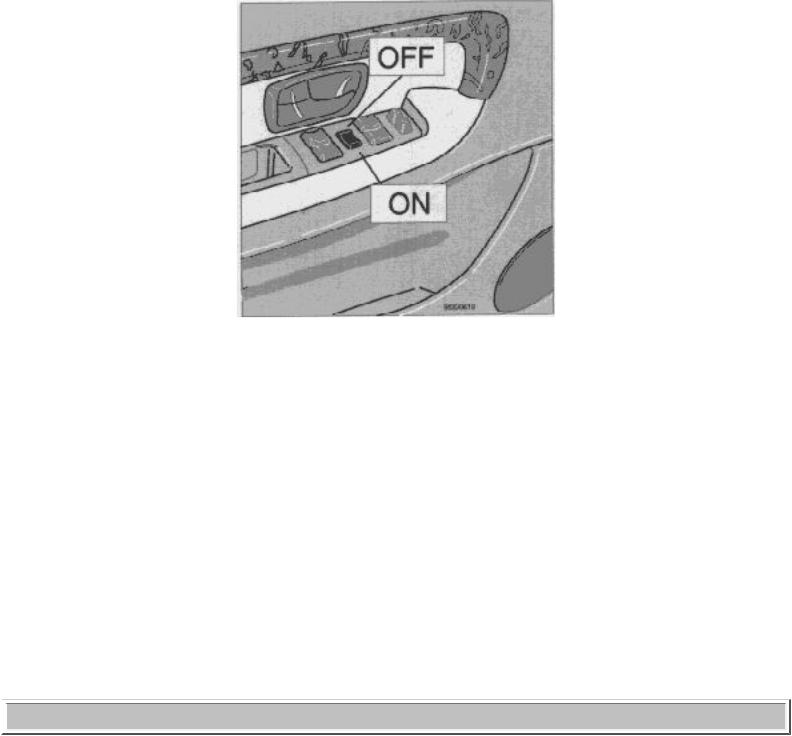
1996 Volvo 960
Cut-out switch for rear-door windows
If the car is equipped with rear door power windows, this function can be disabled by a switch located on the driver's armrest. This switch is positioned 90° in relation to the other switches.
ON The rear door windows can be raised or lowered with the respective door switch as well as the switch on the driver's door.
OFF The rear door windows cannot be raised or lowered with the respective door switch but instead only with the corresponding switch on the driver's door.
NOTE: The power window motors have an overload protecting circuit breaker which is activated when an object blocks a window. Should this occur, remove the object and wait 20 seconds for the circuit breaker to reset. The power windows should then function.
 pg. 1:18 Parking brake, Cigarette lighter, Ash trays
pg. 1:18 Parking brake, Cigarette lighter, Ash trays
file:///K|/ownersdocs/1996/1996_960/96960_116.htm (3 of 6)12/30/2006 10:12:33 AM
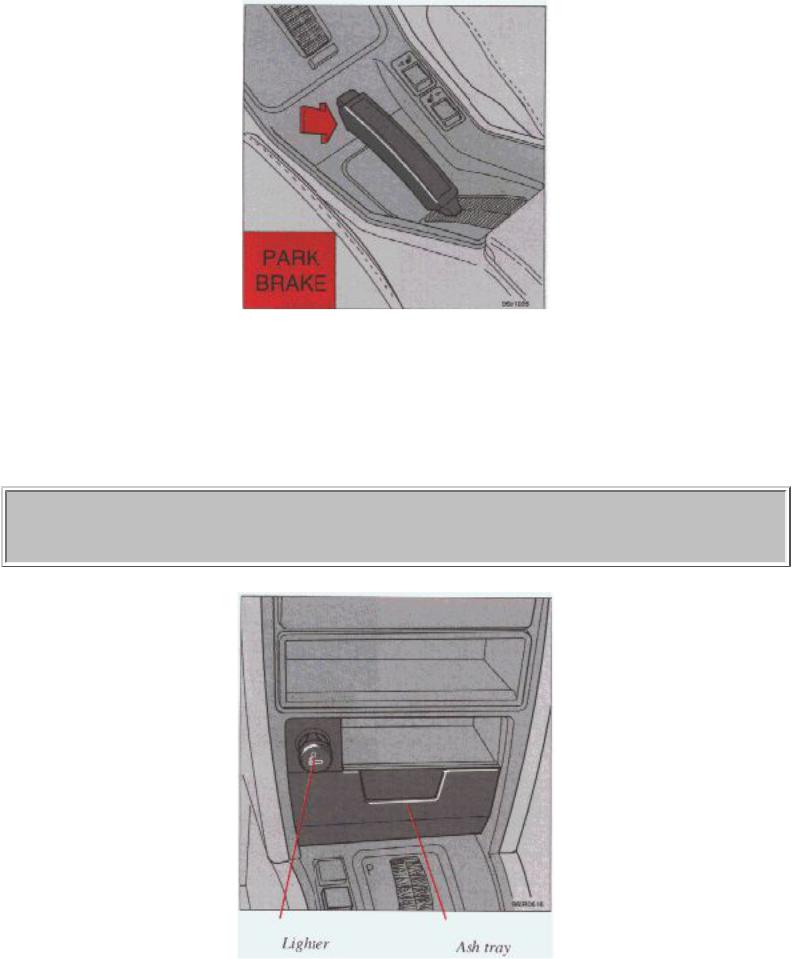
1996 Volvo 960
Parking brake (hand brake)
The lever is situated between the front seats. The brake is applied to the rear wheels.
WARNING!
Always use the parking brake (hand brake) when parking. On hills, also turn the front wheels toward the curb.
file:///K|/ownersdocs/1996/1996_960/96960_116.htm (4 of 6)12/30/2006 10:12:33 AM
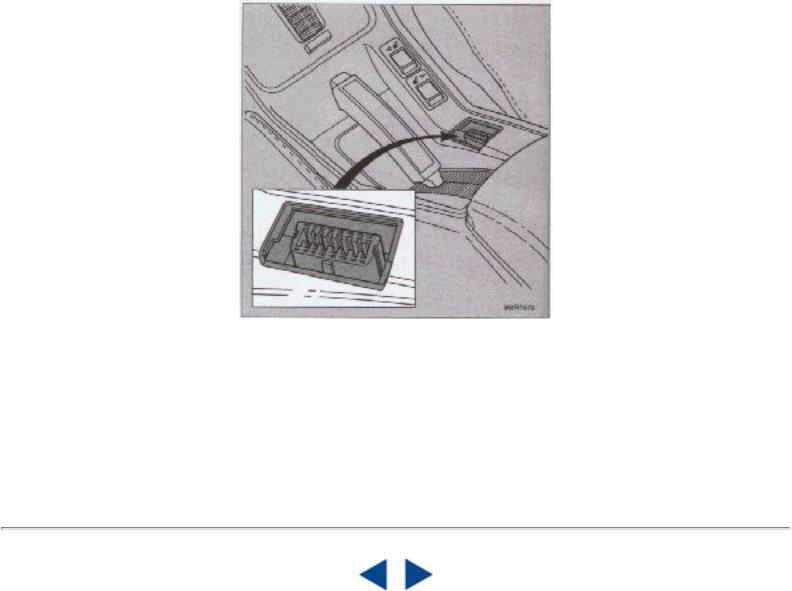
1996 Volvo 960
Cigarette lighter/accessory outlet
To operate, depress the knob fully. When the knob automatically releases, the cigarette lighter is ready for use.
The starting (ignition) switch must be switched on (to position I or II) for the cigarette lighter to function.
Ash trays
To remove the ash trays depress the center spring and remove.
"OBD II"
A connector for on-board diagnostics ("OBD II") is located to the right of the parking brake. This connector is intended for use by authorized service technicians only.
file:///K|/ownersdocs/1996/1996_960/96960_116.htm (5 of 6)12/30/2006 10:12:33 AM
1996 Volvo 960
Contents | Top of Page
file:///K|/ownersdocs/1996/1996_960/96960_116.htm (6 of 6)12/30/2006 10:12:33 AM
